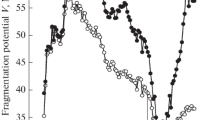Abstract
We analyze the formation of fragments in O—Br reaction at different incident energies between E/A=50 MeV and 200 MeV. This study is carried out within the quantum molecular dynamics (QMD) model coupled with recently advanced simulated annealing clusterization algorithm (SACA). For comparison, we also use the conventional minimum spanning tree (MST) method. Our detailed study shows that the SACA can detect the final stable fragment configuration as early as 60 fin/c which is marked by a dip in the heaviest fragment. On the other hand, the MST method needs several hundred fm/c to identify the final stable distribution. A comparison of the charge distribution with experimental data shows that the SACA is able to reproduce the data very nicely whereas (as reported earlier) the MST method fails to break the spectator matter into intermediate mass fragments. Furthermore, our results with SACA method indicate the onset of multi-fragmentation around 75 MeV/A which is again in good agreement with experimental findings.
Similar content being viewed by others
References
C A Ogilvie et al, Phys. Rev. Lett. 67, 1214 (1991)
M B Tsang et al, Phys. Rev. Lett. 71, 1502 (1993)
R T de Souza et al, Phys. Lett. B268, 6 (1991)
C Williams et al, Phys. Rev. C55, R2132 (1997)
M Begemann-Blaich et al, Phys. Rev. C48, 610 (1993)
G F Peaslee et al, Phys. Rev. C49, R2271 (1994)
K Hagel et al, Phys. Res. Lett. 68, 2141 (1992)
N T B Stone et al, Phys. Rev. Lett. 78, 2084 (1997)
A Schuettauf et al, Nucl. Phys. A607, 457 (1996)
B Jakobsson et al, Nucl. Phys. A509, 195 (1990)
H W Barz et al, Nucl. Phys. A548, 427 (1992); A531, 453 (1991)
J Aichelin, Phys. Rep. 202, 233 (1991)
R K Puri, C Hartnack and J Aichelin, Phys. Rev. C54, R28 (1996)
R K Puri and J Aichelin, J. Comput. Phys. 162, 245 (2000)
S Kumar and R K Puri, Phys. Rev. C58, 320 (1998); C58, 2858 (1998)
S Kumar, R K Puri and J Aichelin, Phys. Rev. C58, 1618 (1998)
J Singh and R K Puri, Phys. Rev. C62, 044617 (2000)
S Kumar and R K Puri, Phys. Rev. C60, 054607 (1999)
J Singh, S Kumar and R K Puri, Phys. Rev. C63, 054603 (2001)
P B Gossiaux, D Keane, S Wang and J Aichelin, Phys. Rev. C51, 3357 (1995)
S R Souza, L de Paula, S Leray, J Nemeth, C Ngô and H Ngô, Nucl. Phys. A571, 159 (1994)
R Donangelo and S R Souza, Phys. Rev. C52, 326 (1995)
S Leray, C Ngô, P Bouissou, B Remaud and F Sebille, Nucl. Phys. A531, 177 (1991)
H W Barz, J P Bondorf, D Idier and I N Mishustin, Phys. Lett. B382, 343 (1996)
Li Zhuxia, C Hartnack, H Stöcker and W Greiner, Phys. Rev. C44, 824 (1991)
W Bauer et al, Phys. Rev. C47, R1838 (1993)
B Jouault, G Royer, J F Lecolley, F Sebille and F Haddad, Nucl. Phys. A615, 82 (1997)
J Singh and R K Puri, Phys. Lett. B519, 46 (2001)
J Singh and R K Puri, Phys. Rev. C65, 024602 (2002) (in press)
J P Bondorf, R Donangelo, I N Mishustin and H Schulz, Nucl. Phys. A444, 460 (1985)
S Pal, S K Samaddar, A Das and J N De, Phys. Lett. B337, 14 (1994)
W Bauer, G F Bertsch and H Schulz, Phys. Rev. Lett. 69, 1888 (1987)
Y G Ma and W Q Shen, Phys. Rev. C51, 710 (1995)
J Konopka, Ph.D. thesis (University of Frankfurt, Germany, 1995) (unpublished)
Author information
Authors and Affiliations
Rights and permissions
About this article
Cite this article
Puri, R.K., Singh, J. & Kumar, S. Fragment production in 16O+80Br reaction within dynamical microscopic theory. Pramana - J Phys 59, 19–31 (2002). https://doi.org/10.1007/s12043-002-0030-7
Received:
Revised:
Issue Date:
DOI: https://doi.org/10.1007/s12043-002-0030-7
Keywords
- Multi fragmentation
- heavy-ion collisions
- quantum molecular dynamics
- simulated annealing clusterization algorithm




